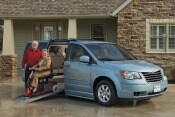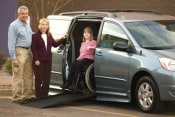These days, there is a wide variety of conversion options available for mobility-challenged drivers and passengers who seek to upgrade their vehicles. If you're new to the world of mobility conversions, stepping into a dealership can be an overwhelming experience. However, by doing the proper research, you can acquire the knowledge necessary to shop with confidence.
Below are 10 points to keep in mind when shopping for conversion upgrades and conversion vehicles. BraunAbility is the world's largest provider of wheelchair-accessible minivans. The company's president, Nick Gutwein, was kind enough to contribute to this article by sharing his insight.

1. Know your options.
Thankfully, you have many alternatives from which to choose when it comes to mobility upgrades. You could install a scooter lift on your vehicle that lifts your scooter or chair and puts it in the trunk. You could install seats that articulate and lift the driver into and out of the vehicle. And of course, you could also opt to convert your vehicle with a ramp for wheelchair access. Which upgrade is best for you? The answer will depend largely upon just how mobile you are.

2. Tap your dealer's expertise.
An informed dealer can help you make sense of the various choices available to you, and can guide you toward the upgrade that best suits your needs. "Maybe the most important thing is to have a local dealer who understands your disability," says Gutwein. "The dealer can help you decide whether to go for a scooter lift, articulating seat or a full van conversion."

3. Choose an accredited dealer.
Mobility dealers differ from regular car dealers in that they need to have 24-hour, 7-day-a-week service capability; if your conversion vehicle has a breakdown, your dealer is expected to be on call to help you address the problem. The dealer's mechanics are also expected to have training that meets certain standards. The National Mobility Equipment Dealers Association (NMEDA) is an organization dedicated to advocating for the provision of safe, reliable modifications in the conversion market. NMEDA offers a Quality Assurance Program (QAP) that's the only nationally recognized accreditation program for the adaptive mobility industry. Dealers who participate in the QAP must meet high standards regarding the services that they provide. Notes Gutwein: "If it's not a QAP dealer, it's a crap shoot."

4. Know the value of experience.
The industry has a lot of people who do customized conversions. You want to avoid someone with a garage shop whose work in this segment is limited to three or four conversions a year; it's very important to choose a dealer who has a history and track record of performance. Look at the number of vans they've converted. How big is the company? Do they have customer satisfaction information? Is there data that shows that customers who've bought from them are happy with the product?
5. Get references.
Dealers or manufacturers should be able to provide you with recommendations of people who've purchased from them in the past. Get in touch with these references, and find out whether they're happy with the service they've received.
6. Consider the warranty.
If you're converting a new vehicle for wheelchair access, you'll want the conversion to offer the same warranty coverage that you get on the chassis: If there's 3-year/36,000-mile coverage on the chassis, for example, that's what you should get on the warranty. Though not all companies provide this, you'll get this level of coverage from a handful of top-tier converters.
7. Get the right fit.
If you're looking at potential conversion vehicles, one of the most important things to consider is the fit. Is the vehicle big enough, given your chair and your size, for you to easily enter and move around in? Also, is it big enough to accommodate the number of passengers that you typically carry? For some, a smaller SUV like the Honda Element will be large enough to do the trick, while others may have to opt for a minivan.
8. Decide whether you want a rear-entry or side-entry modification.
With conversion vehicles, you'll have the option of having your modification accommodate either rear or side entry. In a side-entry van, you can access both the mid-section and front of the vehicle while remaining in your chair. With rear-entry vans, you can typically only access the rear and mid-section of the vehicle while remaining seated. How narrow is your parking space? If you frequently face tight parking spaces, you might be better served by a rear-entry van. "Eighty-seven percent of the market is side entry, but it's still an important question," opines Gutwein.
9. Know the pros and cons of purchasing the chassis separately versus buying the vehicle pre-made.
If you're shopping for a conversion vehicle, you have the choice of either purchasing the vehicle pre-made, or buying a new chassis and then taking it to a conversion shop. There are time savings and convenience benefits associated with buying the vehicle pre-made. However, there may be cost savings associated with buying the chassis separately, if you're able to get a better deal from a non-mobility-focused dealer.
10. Prepare for a long day.
In the mobility market, the dealer works as a consultant, carefully analyzing your needs with the aim of coming up with the product that represents the best solution. As a result, the selling process is typically a long one. Expect to spend at least a few hours in the dealership. You can shorten the process by arriving at the dealership with a clear picture of what your needs are, and what you'd like to accomplish with the conversion.
